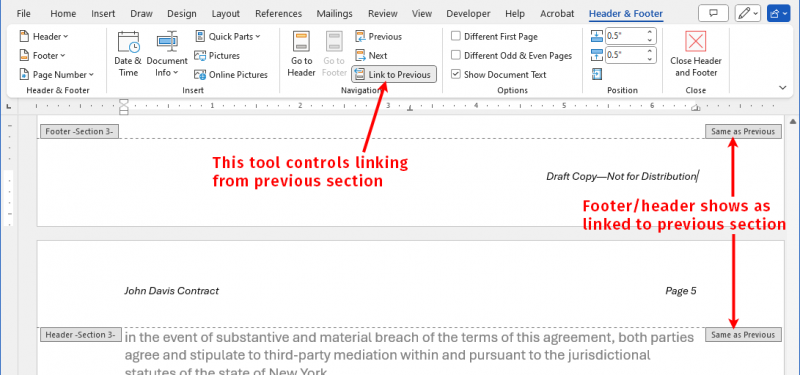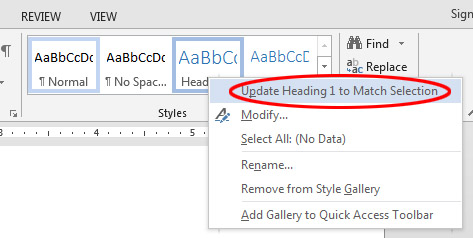

(here we can see our unhyphenated text, with the cursor on “demonstrate”).
#How to remove a header in word 2013 manual#
If you choose the manual hyphenation option, based on where your cursor is placed at the time you select this option, Word will give you a choice of where and whether to hyphenate your words: How do I use manual hyphenation in my document? To remove automatic hyphenation when you find it in a document and don’t want it, highlight the offending text and choose None from the Hyphenation menu in Page Layout > Page Setup:Īll of the automatic hyphenation should disappear. You can do this on unjustified text, too:īut I personally think that this still looks a bit messy.


You can see here that Word has hyphenated all of the longer words that previously caused those big gaps, and made the text an awful lot tidier. So if your text is right justified, you’ll get this: I’m not sure which exact rules Word follows, but a quick look shows that it’s pretty good). If you highlight the text and then select Automatic from the Hyphenation menu, Word will automatically insert hyphens into the text to break the words in sensible, permitted places (there is a whole art to this which I will discuss another time. What happens if I add automatic hyphenation to my document? You can choose here between None, Automatic and Manual, and then have some options, too. If you click on the arrow to the left of the word Hyphenation, you get a menu that looks like this: In Word 2003, you need to select the following menus: Tools > Language > Hyphenation. This is the case in Word 2007 and Word 2010. To work with the hyphenation options, we need to be in the Page Layout tab, and the Page Setup area, and there you’ll find Hyphenation (with a little pop-up box explaining it). How do I add automatic hyphenation to my Word document? Adding automatic or manual hyphenation is the way forward. And poor old Mr Long Word is still dangling a letter onto the next line. Oh no! In its effort to make everything tidy, Word has carefully inserted huge spaces between words (unlike someone typesetting properly on a computer or by hand, it doesn’t space out the letters in the words so much as just add massive spaces). Maybe we can neaten it up by applying Right Justification … In fact, as you can see (marked by the arrow), one word is just too long for the line and splits at the last letter, something which doesn’t obey any of the standard rules of hyphenation (I bet this has happened in your tables – it has in my clients’). If you just put your text in your column and don’t justify it on the right hand side, you will end up with a very ragged look: It is useful, however, if you are working with columns, say in a table, or for a newsletter you’re publishing, or some other part of a document where you want to have a narrow band of text running down the page. Where did all these hyphens come from, I wondered. In fact I hardly ever see it in the work I do, and was only reminded of it when a client had accidentally set automated hyphenation in part of his document that happened to contain long words. This issue doesn’t normally come up with standard documents where the text is in a smallish size and extends across the entire width of the page. Why would I want to add hyphens to a document?
#How to remove a header in word 2013 how to#
When you’re finished, close the Document Inspector dialog and save your changes.This article explains how to add and remove hyphenation in a Word document, and how to work with the options you have in the hyphenation menu. Simply click on Remove All to delete all headers, footers and watermarks in your document. When the Document Inspector dialog box appears, uncheck all boxes except Headers, Footers, and Watermarks. From the Info pane, click on Check for Issues and then select Inspect Document from the pop-up menu.

Open your Word document and go to the File tab of the Ribbon. Method 2: Remove Header or Footer in Word Using Document Inspector You can use the similar methods to remove the headers from your Word document. Now, all text or other stuff in the footers section should disappear. Just click on Footer and then choose Remove Footer from the drop-down menu. Under the Header & Footer tab of the Ribbon, you will see the Header item and Footer item in the sub-item list. Next, click on the Edit Footer button that appeared. Method 1: Remove Header or Footer in Word via Right-clickĪfter opening your Word document, right-click on the footer at the bottom of any page. How can I remove footers from a Word document prior to printing? This header takes up too much space and you need to delete it? In this tutorial we’ll show you easy ways to remove header and footer in Microsoft Office Word 2019 / 2016.


 0 kommentar(er)
0 kommentar(er)
